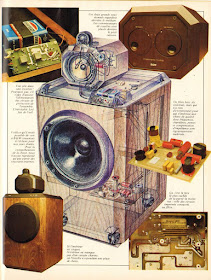This Blog Dedicated To Golden Age Of Audio: Vintage HI-Fi Audio From The 60s, 70s,80s,90s.
My Pages
▼
Sunday, 29 April 2012
Monday, 23 April 2012
Radiotehnika Simfonija
http://vef-rrr.ucoz.ru/index/radiotehnika_simfonija/0-124
Радиола «Simfonija» Сг2.021.039 состоит из 17-лампового AM/ЧМ приемника, стереофонического электропроигрывателя IIЭПУ-12-4-127В с полуавтоматическим включением, автовыключением, микролифтом и двух акустических колонок. Проигрыватель имеет 4 скорости вращения диска: 78, 45, 33.5 и 16.6 об/мин.
Радиола Simfonija позволяет прослушивать стереофонические передачи по принятой в СССР системе с полярной модуляцией и подавленной поднесущей в диапазоне УКВ при помощи специальной приставки (здесь ее схема). Приемник построен по принципу функциональных блоков, которых имеется 7: блок УКВ, блок ЭПУ, блок КСДВ, блок ПЧ, блок АПЧ, блок УНЧ и блок питания.
В каждой акустической колонке радиолы установлено по 4 громкоговорителя: низкочастотный 5ГД-3РРЗ, два среднечастотных 2ГД-28, высокочастотный 3ГД-15 и разделительные фильтры. Внешний вид этих колонок показан в авторской статье. Они похожи на колонки, разработанные для радиолы "Teika". Позднее появились колонки, показанные на фото вверху и на схеме. Для лучшего воспроизведения низших звуковых частот применена закрытая акустическая система с несколькими объемными резонаторами.
Технические характеристики:
Диапазоны:
ДВ: 2000 - 735 м (150 - 408 кГц); СВ: 571 - 187 м (525 - 1605 кГц); УКВ: 65.8 - 73 МГц (4.56 - 4.11 м);
КВ1: 25 м (11.7 - 12.0 МГц); КВ2: 31 м ( 9.5 - 9.8 МГц); КВ3: 41 м (7.1 - 7.3 МГц); КВ4: 49 м (5.9 - 6.2 МГц)
ПЧ АМ - 465 кГц
ПЧ ЧМ - 6.5 МГц
Чувствительность приемника при работе с внешней антенной и выходной мощности 50 мВт в диапазоне УКВ составляет 2 мкВ, в диапазонах ДВ, СВ и KB - 20 мкВ при отношении сигнал/шум 20 дБ
Чувствительность при работе с внутренней магнитной антенной в диапазонах ДВ и СВ - 1 мВ/м
Чувствительность приемника в фиксированном положении "местный прием" в диапазонах ДВ и СВ - 0.7 мВ
Ширина полосы пропускания приемника в тракте AM при ослаблении сигнала 6 дБ в положении "широкая полоса" - 12 кГц, в положении "узкая полоса" - 5 кГц; в тракте ЧМ ширина полосы пропускания - 140 кГц
Система АРУ обеспечивает изменение сигнала на выходе приемника 6,5 дБ при изменении сигнала на входе 60 дБ
Коэффициент автоматической подстройки частоты 15 раз
Максимальная мощность усилителей НЧ - 6 Вт
Диапазон воспроизводимых частот от 40...15000 Гц
Пределы регулировки тембра относительно частоты 1000 гц - 15 дБ
Чувствительность усилителя с гнезд звукоснимателя при номинальной выходной мощности 180 мВ
Уровень фона - 64 дБ
Потребляемая мощность 125 Вт.
Радиола имеет два варианта внешнего оформления. В одном электропроигрыватель расположен рядом с приемником, в другом - над ним
Размеры радиолы первого варианта 1085х285х345 мм, масса 28 кг; второго варианта 660х320х360 мм, масса 25 кг
Каждая звуковая колонка имеет размеры 450х1000х320 мм и весит 20 кг
http://vef-rrr.ucoz.ru/
Monday, 16 April 2012
Luxman L-550 integrated amplifier
http://photo.qip.ru/users/vintagist/96642141/
http://audio-database.com/LUXMANALPINE-LUXMAN/amp/l-550-e.html
Luxman L-550
Designed and produced before the Alpine "takeover / collaboration" and just before the DAD revolution, the L-550 did receive a "State of the Art" award in 1982 besides being selected as "Best Product" by Stereo Sound.
Most of the direct followers also became Stereo Sound "Best Product" : L-550X, L-560 and the successful L-540 and L-570.
All are versions of the same basic circuit : Single-Stage amplification, Duo-ßeta, plus-X, Circuit /S and Class A all the way, real hot Class A.
All did also sport something which was not to be discarded once the fad faded : double Heat-Pipes !
Power supply
Feeding all is a big 400VA EI transformer and two low-ESR 50V / 30,000µF 99,99% pure aluminium chemical caps.
Six windings feed separately the pre-driver, main Duo-ß, phono MM EQ amp, phono MM EQ Duo-ß, phono MC and protection / regulation / muting / pre-heating stages.
The power amp is fed separately from the secondary.
The necessary Heat-Pipes have vents top and bottom of the enclosure : 2x 50W of pure Class A produces heat, especially when idling current is to be set at 160mV for each channel !
The pre-Heating switch is used to get the L-550 reach its cruising speed while the power-on button is off ; current is cut from the final transistors but heats-up the rest of the circuit.
Single-Stage amplifier
As in all contemporary Luxmans, there is no second stage so the 1st stage uses a high Gm low-noise FET (for the MC input) with a 7mA current for the necessary gain.
If Duo-ßeta is used as usual in the power-supply, in the L-550, it also was implemented in the EQ phono section - that's Duo-ßeta Circuit /S.
Line level input reach the circuit where the "phono straight" mode starts, the latter bypassing the subsonic, high-cut, monitor and source selectors.
Unlike other contemporary LUX amps, the 9-turnover NF tone controls are not placed withing the power amp's main Duo-ßeta loop but the Linear Equalizer which can subtly tilt RIAA frequency response is.
The attenuator is a 2-gang 50kOhm pot sourced from, as always and for nearly everybody, ALPS, aka Alpine :)
Other features are... plenty :
Line-Phase sensor, front supplementray phono input, tape i/o and headphones output, three-way tape monitoring, 4-way tape dubbing, 6-position phono setting and warm-up indicator.
Plus pre/main i/o, all engraved front scripting and rosewood enclosure.
As for all of the L-550 series, the smaller models are, sonically, energetic bolids and the bigger models more relaxed providers : L-530 vs. L-550, L-530X vs. L-550X, L-535 vs. L-560 and L-540 vs. L-570.
Friday, 13 April 2012
Web pages about speakers and horns, DIY
Web pages about speakers and horns, DIY here you can link to interesting homepages about horns and speakers, you have found on the net:
http://www.audiovoice-acoustics.com/forum/showthread.php?t=168
http://www.hifisentralen.no/forum/arkiv.php?topic=54693.0
http://www.audiovoice-acoustics.com/forum/showthread.php?t=168
http://www.hifisentralen.no/forum/arkiv.php?topic=54693.0













